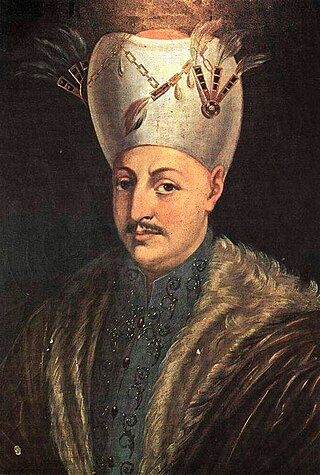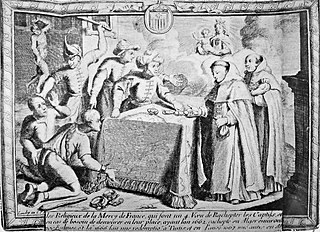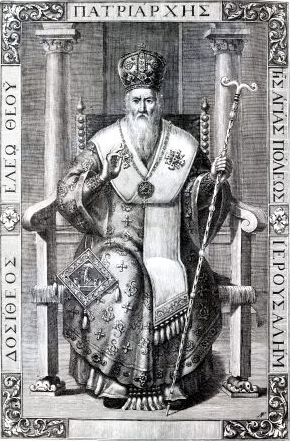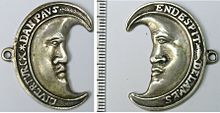
Ahmed I was the sultan of the Ottoman Empire from 1603 to 1617. Ahmed's reign is noteworthy for marking the first breach in the Ottoman tradition of royal fratricide; henceforth, Ottoman rulers would no longer systematically execute their brothers upon accession to the throne. He is also well known for his construction of the Blue Mosque, one of the most famous mosques in Turkey.

Year 1453 (MCDLIII) was a common year starting on Monday of the Julian calendar, the 1453rd year of the Common Era (CE) and Anno Domini (AD) designations, the 453rd year of the 2nd millennium, the 53rd year of the 15th century, and the 4th year of the 1450s decade.

Constantine XI Dragases Palaiologos or DragašPalaeologus was the last Roman (Byzantine) emperor, reigning from 1449 until his death in battle at the Fall of Constantinople in 1453. Constantine's death marked the definitive end of the Eastern Roman Empire, which traced its origin to Constantine the Great's foundation of Constantinople as the Roman Empire's new capital in 330.

Geuzen was a name assumed by the confederacy of Calvinist Dutch nobles, who from 1566 opposed Spanish rule in the Netherlands. The most successful group of them operated at sea, and so were called Watergeuzen. In the Eighty Years' War, the Capture of Brielle by the Watergeuzen in 1572 provided the first foothold on land for the rebels, who would conquer the northern Netherlands and establish an independent Dutch Republic. They can be considered either as privateers or pirates, depending on the circumstances or motivations.

Habsburg Spain refers to Spain and the Spanish Empire, also known as the Catholic Monarchy, in the period from 1516 to 1700 when it was ruled by kings from the House of Habsburg. It had territories around the world, including modern-day Spain, a piece of south-eastern France, eventually Portugal and many other lands outside the Iberian Peninsula, like in the Americas. Habsburg Spain was a composite monarchy and a personal union. The Habsburg Spanish monarchs of this period are chiefly Charles I, Philip II, Philip III, Philip IV and Charles II. In this period the Spanish empire was at the zenith of its influence and power. Spain, or "the Spains", referring to Spanish territories across different continents in this period, initially covered the entire Iberian peninsula, including the crowns of Castile, Aragon and from 1580 Portugal. It then expanded to include territories over the five continents, consisting of much of Latin America and the West Indies in the Americas, the Low Countries, Belgium, Luxembourg, Italian territories and France in Europe, Portuguese possessions such as small enclaves like Ceuta and Oran in North Africa, and the Philippines and other possessions in Southeast Asia. The period of Spanish history has also been referred to as the "Age of Expansion".
"Better dead than red" and the reverse "better red than dead" are dueling slogans regarding communism, and generally socialism, the former anti-communist slogan and the latter pro-communist slogan.
Joseph Nasi, known in Portuguese as João Miques, was a Portuguese Sephardi diplomat and administrator, member of the House of Mendes/Benveniste, nephew of Dona Gracia Mendes Nasi, and an influential figure in the Ottoman Empire during the rules of both Sultan Suleiman I and his son Selim II. He was a great benefactor of the Jewish people.
Loukas Notaras was a Byzantine Greek statesman who served as the last megas doux or grand Duke and the last mesazon of the Byzantine Empire, under emperors John VIII Palaiologos and Constantine XI Palaiologos.

The foreign relations of the Ottoman Empire were characterized by competition with the Persian Empire to the east, Russia to the north, and Austria to the west. The control over European minorities began to collapse after 1800, with Greece being the first to break free, followed by Serbia. Egypt was lost in 1798–1805. In the early 20th century Austria-Hungary annexed Bosnia and Herzegovina, the Bulgarian Declaration of Independence soon followed. The Ottomans lost nearly all their European territory in the First Balkan War (1912–1913). The Ottoman Empire allied itself with the Central Powers in the First World War, and lost. The British successfully mobilized Arab nationalism. The Ottoman Empire thereby lost its Arab possessions, and itself soon collapsed in the early 1920s. For the period after 1923 see Foreign relations of Turkey.

The Ottoman–Hungarian Wars were a series of battles between the Ottoman Empire and the medieval Kingdom of Hungary. Following the Byzantine Civil War, the Ottoman capture of Gallipoli, and the decisive Battle of Kosovo, the Ottoman Empire was poised to conquer the entirety of the Balkans and also sought and expressed desire to expand further north into Central Europe beginning with the Hungarian lands.

The Fourth Ottoman–Venetian War, also known as the War of Cyprus was fought between 1570 and 1573. It was waged between the Ottoman Empire and the Republic of Venice, the latter joined by the Holy League, a coalition of Christian states formed by the pope which included Spain, the Republic of Genoa, the Duchy of Savoy, the Knights Hospitaller, and the Grand Duchy of Tuscany.

The Franco-Ottoman alliance, also known as the Franco-Turkish alliance, was an alliance established in 1536 between Francis I, King of France and Suleiman I of the Ottoman Empire. The strategic and sometimes tactical alliance was one of the longest-lasting and most important foreign alliances of France, and was particularly influential during the Italian Wars. The Franco-Ottoman military alliance reached its peak with the Invasion of Corsica of 1553 during the reign of Henry II of France.

The Morea revolt of 1453–1454 was a failed peasant rebellion carried out against the rule of the brothers Thomas and Demetrios Palaiologos, rulers of the Byzantine Despotate of the Morea in the Peloponnese peninsula.
On War Against the Turk was a book written by Martin Luther in 1528 and published in 1529. It was one of several pamphlets and sermons by Martin Luther about Islam and resistance to the Ottoman Empire, during the critical period of territorial expansion of the Ottoman Empire in Europe, marked by the capture of Buda in 1526 and the siege of Vienna in 1529.
Protestantism and Islam entered into contact during the early-16th century when the Ottoman Empire, expanding in the Balkans, first encountered Calvinist Protestants in present-day Hungary and Transylvania. As both parties opposed the Austrian Holy Roman Emperor and his Roman Catholic allies, numerous exchanges occurred, exploring religious similarities and the possibility of trade and military alliances.

The conquest of Tunis in 1574 marked the conquest of Tunis by the Ottoman Empire over the Spanish Empire, which had seized the place a year earlier. The event virtually determined the supremacy in North Africa vied between both empires in favour of the former, sealing the Ottoman domination over eastern and central Maghreb, with the Ottoman dependencies in Algiers, Tunis and Tripoli ensuingly coming to experience a golden age as corsair states.

Anglo-Turkish piracy or the Anglo-Barbary piracy was the collaboration between Barbary pirates and English pirates against Catholic shipping during the 17th century.

Dositheus II Notaras of Jerusalem was the Greek Orthodox Patriarch of Jerusalem between 1669 and 1707 and a theologian of the Eastern Orthodox Church. He was known for standing against influences of the Roman Catholic and Protestant churches. He convened the Synod of Jerusalem to counter the Calvinist confessions of Cyril Lucaris.

The siege of Famagusta happened in Venetian-controlled Famagusta, the last Christian possession in Cyprus. Famagusta fell to the Ottomans in August 1571 after a siege that lasted nearly a year.

The period between the Capture of Brielle and the Pacification of Ghent was an early stage of the Eighty Years' War between the Spanish Empire and groups of rebels in the Habsburg Netherlands.















